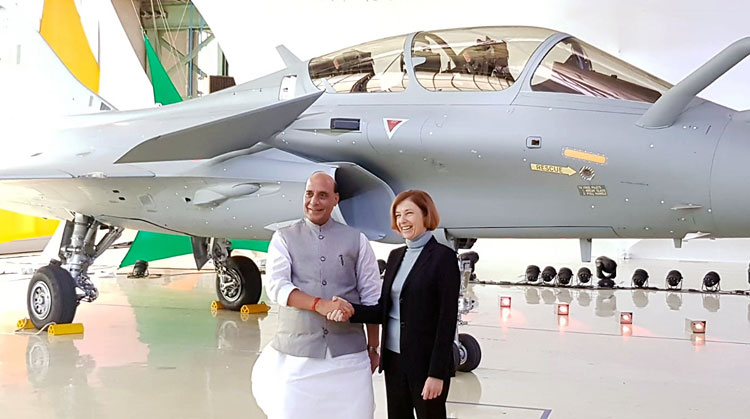INDIAN ARMED FORCES CHIEFS ON
OUR RELENTLESS AND FOCUSED PUBLISHING EFFORTS

SP Guide Publications puts forth a well compiled articulation of issues, pursuits and accomplishments of the Indian Army, over the years

I am confident that SP Guide Publications would continue to inform, inspire and influence.

My compliments to SP Guide Publications for informative and credible reportage on contemporary aerospace issues over the past six decades.
Coming – Rafale Fighters
 |
The Author is Former Director General of Information Systems and A Special Forces Veteran, Indian Army |

There have been some queries about what has happened to delivery schedule of the Rafale fighters with onboard India specific systems that were expected to have started arriving by end May 2020. But delays on account of the COVID-19 pandemic that France too is battling were naturally expected. On May 30, Defence Minister Rajnath Singh had a telephonic conversation with his French counterpart Florence Parly during which she conveyed that the Rafale jets will be delivered to India as scheduled. Apparently, due to the shutting down of the Dassault Aviation facility in Mérignac, the manufacturing of these aircraft had to be put on hold. However, after the lockdown was lifted, the work has started, as also the training of personnel with stringent COVID-19 protocols in place.
It may be recalled that the deal for 36 French fighters was inked at 7.8 billion euros with the French government in September 2016. The deal had created quite a political controversy in India and the case had even gone to the Supreme Court which finally gave a clean chit to the government in November 2019 dismissing a batch of review petitions on the Rafale jet deals. A month earlier in October 2019, India had received the first Rafale fighter in a ceremony in France attended by Defence Minister Rajnath Singh who received the first of 36 Rafale fighter jets on behalf of the Indian Air Force (IAF) at the Merignac air base near the French port city of Bordeaux. These fighter aircraft from French Dassault Aviation will boost the air power of the IAF for operations along the eastern, northern and western borders. Post the telephonic conversation between the two defence ministers on May 30, the Ministry of Defence (MoD) released a statement that read, “The two ministers also discussed further strengthening of defence cooperation between India and France. Both also agreed to work together to fulfill the India-France joint strategic vision on the Indian Ocean Region.” IAF Chief Air Chief Marshal R.K.S. Bhadauria in an interaction with media had said that though the deliveries are on track in France, however, ferrying of the Rafale fighters will be delayed towards the end of July. These aircraft can easily integrate with the existing fleets in the IAF and will enhance the overall combat potential and deterrence value. It has been reported in French media that the first four, out of the 36 Rafale fighters that India had ordered, will fly to the Ambala Airbase by July 2020 end, and will include three twin-seat and one single-seater fighter.

The first Rafale is expected to be commanded by the Commanding Officer of the IAF’s 17 Squadron ‘Golden Arrows’ who will be accompanied by a French pilot while ferrying the aircraft to India. On the way, the aircraft is likely to be fuelled by a French Air Force Tanker and the Russian IL-78. The Rafale jets fighters are categorised as 4.5 generation fighters. These aircraft are known for their speed, weapon holding capacity and attack capability. Rafale is powered by two SNECMA M88 engines that help it to attain a high speed of 1,912 km per hour. The fighter jet has a range of more than 3,700 km and also has the capability to deliver nuclear weapons. These fighters are equipped with the AESA radar, SPECTRA Electronic Warfare System and IRST system. The Rafale ordered by India will be equipped with Meteor missile, which can shoot down an enemy aircraft over 100 km away without crossing into airspace of the enemy. Meteor is an active radar guided beyond-visual-range air-to-air missile developed by MBDA. Meteor offers a multi-shot capability against long range maneuvering targets, jets, UAVs and cruise missiles in a heavy electronic countermeasures environment. Also, there is a 1,300 kg, Scalp long-range air-to-ground stand-off cruise missile. It has the capability to strike almost 600 km into enemy territory. The Scalp (also called Storm Shadow) is a long-range air-launched stand-off attack missile designed and developed by MBDA that was designed primarily for UK and French armed forces. Scalp was derived from MBDA’s ‘Apache’ anti-runway missile. Other India specific enhancements include radar warning receivers, low band jammers, 10-hour flight data recording, infra-red search and tracking systems.
Of the 36 Rafale fighter jets India is getting, 18 will serve with IAF’s 17 Squadron ‘Golden Arrows’ at Ambala Airbase which is some 220 km from the Indo-Pak border. The balance 18 Rafale fighter jets will serve with IAF’s 101 Squadron ‘Falcons’ at Hashimara Air Force Station in northeast India.





